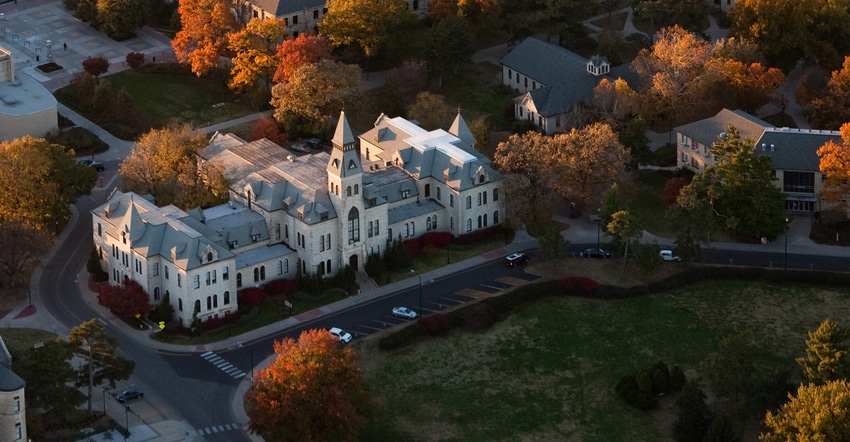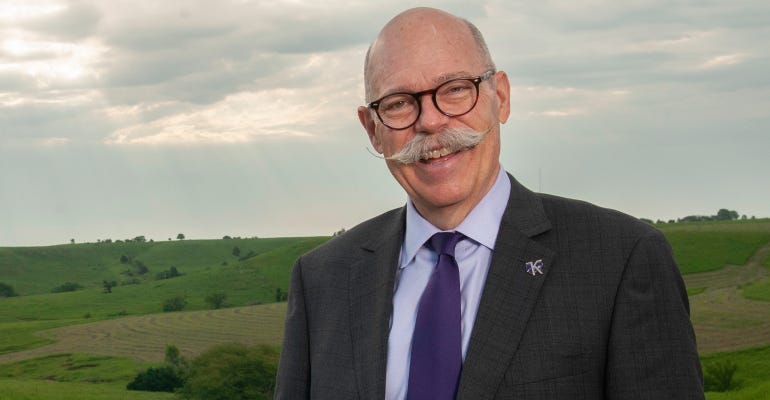August 2, 2021

Public investments in food and agricultural research have arguably not only led to a secure food supply for the United States, but they’ve also made this nation a world leader in food and agricultural productivity. In the U.S., ag, food and related industries contribute $1.1 trillion annually to the nation’s economy, supporting 22 million jobs. In Kansas, ag is 54% of the state’s economy and accounts for 21% of the workforce.
Ernie Minton is dean of the College of Agriculture at Kansas State University and director of K-State Research and Extension. Minton also serves as the chair-elect for the Association of Public and Land-grant Universities (APLU) Board on Agricultural Assembly Policy board of directors. In “U.S. agriculture research facilities badly out of date,” an editorial that ran in the June 20 Kansas CIty Star, Minton writes that in order for the U.S. to continue to compete in the global marketplace and ensure our national security, we need to invest in the infrastructure of our public research institutions.

DEAN MINTON: Ernie Minton, dean of K-State College of Agriculture and director of K-State Research and Extension, says 69% of all research buildings across the nation’s public institutions are more than 25 years old. That age hinders research and teaching — which, if left unchecked — can lead to the U.S. dropping behind global competitors in the ag marketplace.

“A compounding problem is clear when you walk through any of the nation’s agricultural schools, including K-State,” he writes. “You will see research facilities built in the 1950s and 1960s with failing utility systems, leaky roofs, and outdated technology and equipment. According to a report just released by the APLU, 69% of all agriculture research buildings across the country are more than 25 years old and require urgent upgrades.”
Kansas Farmer sat down with Minton to discuss this pressing dilemma — how do we expect our nation’s food and ag researchers to deliver 21st-century results and teach the next generation of innovators when we are using crumbling and outdated infrastructure?
Can you provide an example of how our lack of upgraded infrastructure or deferred maintenance has limited our research and teaching capabilities? So, I’m going to just focus on wheat, as an example, because that’s something K-State has been known for and continues to be known for. The last time we had new infrastructure on our Manhattan campus to house the work of our wheat breeder was in the late 1980s and early 1990s, and that’s Throckmorton Hall and the associated greenhouse complex.
It was built 30 years ago, and it’s the College of Agriculture’s newest building. So, at that age, many buildings begin to lose functionality of their core mechanical facilities, other internal and external systems.
Shellenberger Hall, which studies the value-added components and milling of that wheat research, was a structure built in the 1950s — and that’s a building that’s 70-plus years old! We’ve had architectural and engineering studies done on that building, and it is past renovation.
And that’s just in the wheat program. Sounds like there’s a need across the spectrum of crop and livestock research infrastructure. For example, the dairy farm needs to upgraded so it resembles a modern dairy for teaching students, right? That’s true. And it’s a matter of taking students out to a facility and telling them, “Well, you’ll never see a milking parlor this old, but this is what we have.” And it really puts our teaching faculty in a very difficult position to be teaching and conducting research that is supposed to address modern challenges, modern problems, in facilities that are so outdated.
Our staff is creative, and they find workarounds and do the best they can; but the more you do that, the more inefficient the research activity becomes. And so it really ends up costing more.
I want to emphasize this is not just a K-State issue. Nearly every agriculture school in this country struggles with these same types of challenges caused by outdated research facilities.
How much would it cost to upgrade our nation’s research infrastructure? The estimate is [that] nationwide, across 97 institutions, it would cost $11.5 billion to catch up on renovations and repairs. And an additional annual investment of about $550 million a year to maintain them.
In an ideal world, both public funds could be matched with some private funding. But it’s difficult to imagine how any one source could get us to that kind of total.
However, appropriate language is already in the 2018 Farm Bill. The Research Facilities Act is embedded in that bill, so it’s already teed up; we just need Congress to authorize and appropriate the significant number of dollars, hopefully as part of a larger infrastructure bill.
So, beyond the cost to the education of the next generation of ag innovators and current research projects, isn’t there also a cost to the U.S. ag economy? Agricultural economists have documented that for every $1 of funding that is attributed to food and agriculture research and development, $17 is returned in economic impact. Other countries out there are not divesting from funding their ag research and development, and you can expect, over time, that will show up in terms of the competitiveness of the farmers, ranchers or agricultural producers in those countries that are investing.
For example, one big research area that we should be looking to invest in to stay competitive would be modern precision ag research. Sensors, precision planting, precision applications of herbicides, cloud-based data, those kinds of things. And infrastructure also includes the people to do the work as well.
Would you say that this topic, researching food and agriculture, also relates to our national security? I really do think that in some ways, addressing this research infrastructure backlog is an important part of the agricultural economy in the nation and in Kansas. I don’t think it’s hyperbole to say that our national security could be at risk if we don’t address this, because a supply of safe and abundant food is certainly in the nation’s security interest. We saw during the pandemic what disruptions did to certain elements of the food supply chain.
And the nation’s land-grant universities not only generate that knowledge that’s needed, but they do the research into advancements that are needed to address the growing global population’s need for food.
You May Also Like




